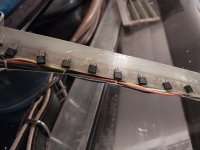accordionsrule
Newbie
Hi. A bass key died due to one of the wires of the sensor being broken, looks like the magnet has been hitting it. I got the number off the sensor, and I can't find the same sensor on the internet. It's old, it's not a brand name midi system and the maker is deceased. I don't know how universal these accordion sensors are. I wonder if there's somebody that can match the sensor for me and sell me a couple, maybe the resistor too, I can solder it in. I took the bass section apart to get to this and I don't want to put it back together and ship it out only to be told they will need to install a complete new midi system. It seems simple enough and I just want to try replacing the one broken sensor. Thanks for any assistance or suggestions.


